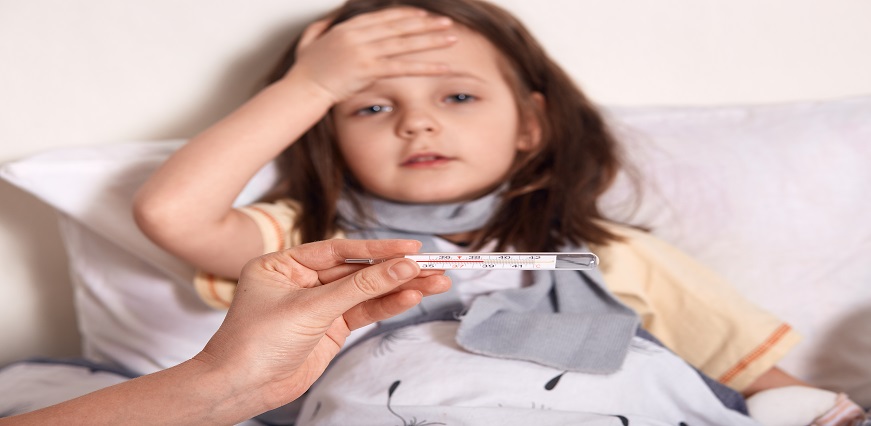





No lab centers are available in this city

Kawasaki disease is a syndrome with unknown causes that results in a fever and mostly affects children under the age of five. It's usually a form of vasculitis, where blood vessels throughout the body become inflamed. Patients typically have fevers for more than five days, which are not helped by regular medications. Other symptoms include swollen lymph nodes in the neck, red eyes, and dry spots on the hands and feet. Within three weeks of developing Kawasaki disease, patients may notice their skin peeling from the palms and soles of the feet. The skin regrows after this time and recovery typically occurs. In some children, coronary artery aneurysms may form within three weeks of the onset of Kawasaki disease.
Kawasaki disease is a medical condition that causes the blood vessels in your body to swell and become inflamed. The exact cause of this illness is unknown, though it's been speculated to have something to do with an infection, due to its sudden onset and high fever accompanied by swelling lymph nodes. This isn't considered a contagious disease.
Without treatment, Kawasaki disease can result in serious complications that may not be recognized at first. The symptoms often go away with time (the child recovers), but without medical evaluation and treatment serious consequences can occur.
Children under the age of five are often affected by Kawasaki disease. The majority of people diagnosed are less than two years old. Sometimes, Kawasaki disease can affect older kids, too. It's most commonly seen in boys and it's more likely to occur in the winter and spring months.
The cause of Kawasaki disease is unknown, but it is thought to be caused by a combination of genetic and environmental factors. Some research suggests that the disease may be triggered by an infection, such as a viral infection, but this has not been proven.
There are a few different symptoms that are associated with Kawasaki disease. The most common symptom is a fever that lasts for more than five days. Other symptoms include:
If your child is exhibiting any of these symptoms, it's important to contact your doctor immediately.
There is no one definitive test for Kawasaki disease, so diagnosis usually relies on a combination of clinical signs and symptoms. In general, doctors will look for:
In addition, blood tests may be done to check for inflammation and an abnormal increase in white blood cells. An echocardiogram (heart ultrasound) may also be ordered to check for heart damage.
There is no specific cure for Kawasaki disease, but fortunately, most children who develop the condition make a full recovery with treatment. Treatment typically involves hospitalization so that your child can be monitored closely and receive intensive care, if needed.
The main goals of treatment are to reduce inflammation in the arteries and prevent complications. Treatment typically includes:
There is no certain way to prevent Kawasaki disease, however, early diagnosis and treatment is critical. Some tips to help prevent the disease include:
If your child has a fever for more than five days and you notice any of the other symptoms listed above, it’s important to consult a doctor right away. Early diagnosis and treatment is critical to preventing serious complications from Kawasaki disease.
 Allergy Test
Allergy Test
 Anemia Test
Anemia Test
 Auto immune
Auto immune
 Blood disorder
Blood disorder
 Bone and Joint
Bone and Joint
 Cancer Test
Cancer Test
 Cardiology Test
Cardiology Test
 Covid Recovery
Covid Recovery
 Dengue Test
Dengue Test
 Depression
Depression
 Diabetes Test
Diabetes Test
 Fatigue
Fatigue
 Fever Test
Fever Test
 Full body
Full body
 Gastro Test
Gastro Test
 Gastrointestinal
Gastrointestinal
 Gynaecology Test
Gynaecology Test
 Heart Test
Heart Test
 HIV Test
HIV Test
 Hormone Test
Hormone Test
 Hypertension
Hypertension
 Immunity Test
Immunity Test
 Infectious Disease
Infectious Disease
 Infertility Test
Infertility Test
 Influenza Test
Influenza Test
 Iron Test
Iron Test
 Kidney Test
Kidney Test
 Liver Test
Liver Test
 Lung Test
Lung Test
 Nephrology
Nephrology
 Obesity
Obesity
 Orthopedics Test
Orthopedics Test
 Physician
Physician
 Pollution Health Checkup
Pollution Health Checkup
 Pregnancy Test
Pregnancy Test
 Prostate Test
Prostate Test
 Senior Citizen Test
Senior Citizen Test
 STD Test
STD Test
 Thyroid Test
Thyroid Test
 Tuberculosis Test
Tuberculosis Test
 Vitamin Test
Vitamin Test
 Women Health Test
Women Health Test
Sign up takes less than 60 secs and gives you access to your offers, orders and lab tests.
Looks like you are not registered with us. Please Sign up to proceed
OTP will be sent to this number by SMS
We have successfully received your details. One of the agents will call you back soon.
 To reach our help desk call 9213188888
To reach our help desk call 9213188888
No Lab Centers are available in this city
Looks like you are not registered with us. Please Sign up to proceed
OTP will be sent to this number by SMS
Not Registered Yet? Signup now.Looks like you are not registered with us. Please Sign up to proceed





 7982100200
7982100200.png)